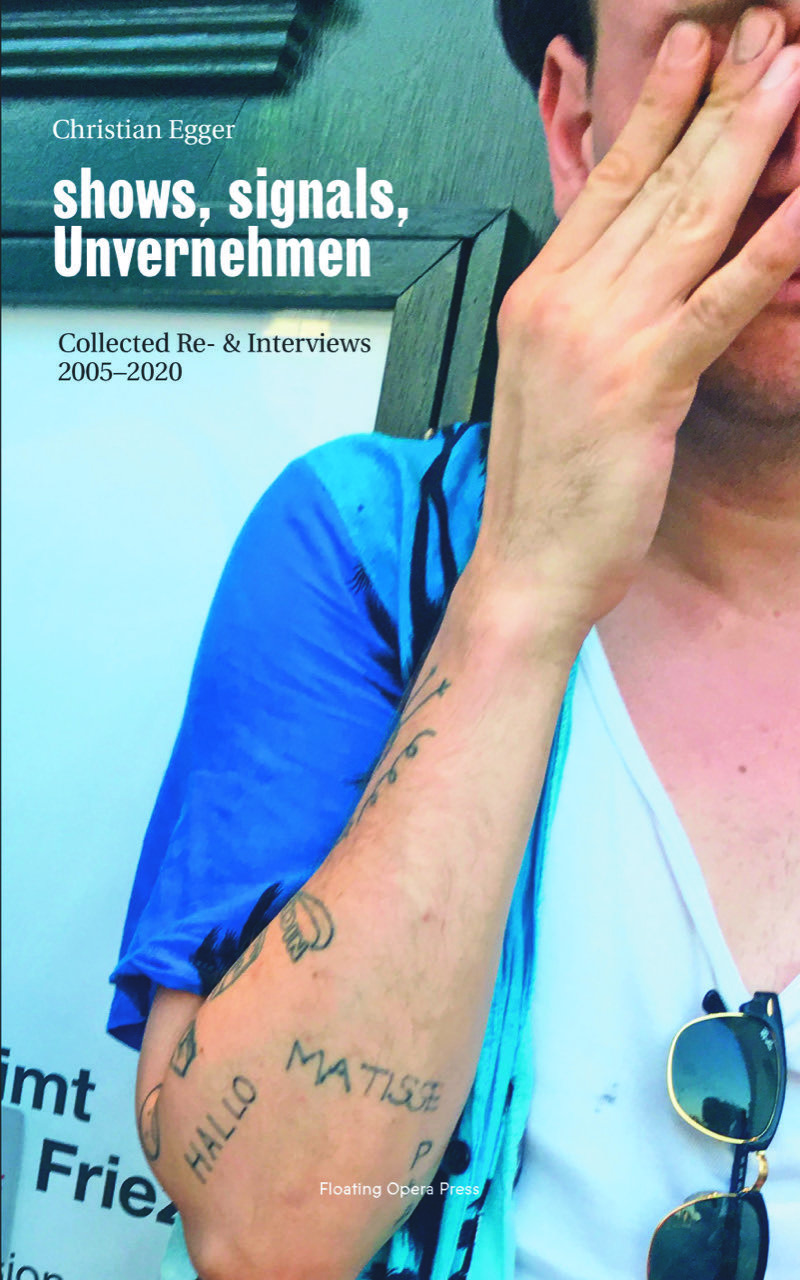Writing on Art
Shows, Signals, Unvernehmen
Christian Egger & Margit Neuhold
Talk

shows, signals, Unvernehmen
Photo: HK
The series Writing about Art presents current art criticism at irregular intervals. Here, art critics and their work are introduced, gladly in conversation with a colleague. Writing about art is essential for artists, the art business and the mediation of art productions. A good text can be just as “valuable” as a work of art; it is not by chance that artists and writers who appreciate each other sometimes exchange their “works”. Due to various circumstances, dedicated art criticism has been under pressure for a long time, which makes substantial text production even more difficult. At the same time, theory formation (and art education) is becoming increasingly academicized. What may be well-intentioned is at least ambivalent in its consequences; there seem to be connections here. What remains is the claim to the text, what may come up in writing about art.
The book Shows, Signals, Unvernehmen brings together texts by the art critic, curator and artist Christian Egger from the years 2005 to 2020. This book contains interviews with artists such as Jutta Koether, Amelie von Wulffen and Gelitin, among others, as well as reviews for art magazines such as Camera Austria, Springerin and Spike. This exemplary collection not only offers an overview of the exhibition practice of contemporary art production, especially in Austria during this period, but also describes the critical reflection and an intensive examination of the different variants, tendencies and protagonists of these years. With a foreword by Martin Herbert and drawings by the artist Ebecho Muslimova.
“When I was an art student in the early to mid-1990s, I spent at least as much time in the university library as I did in the studio, nosing through bound volumes of art magazines from recent years. Marooned in the provinces and far from a lively art scene, I was trying to understand recent practice through the most concise critical form: the short exhibition review. Most of what I read was fairly dry and theory-laden, and seems now to belong to a different world. Art criticism has morphed and mutated several times over since then; it’s a different beast too than it was in the early 2000s, when most of it wasn’t going online, i.e., meeting an audience who hadn’t committed to paying a magazine’s cover price. One significant marker of change is that the format is, nowadays, equally often referred to as “art writing.” That’s a more open designation than criticism, neither better nor worse, I think, and contains a range of assumptions within it.
First among these, and most obvious, is that writing about art is not always predicated on being directly critical — often it is advocacy, the critical act being subsumed within the decision of who to write about, who to exclude. Sometimes, meanwhile, it involves interviewing the artist, in the accessible format of the Q&A, to tease out the mechanics of their practice and reveal the depth of their thinking. But the blown-out designation of art writing, to the extent that it’s used, has also seemed to anticipate the germination or popularizing of a wide range of modes for thinking-in-language about art and its milieu, from the experimental essay to the sociable constraint of the first-person column, and, not least, the volatile voice of the artist-as-critic. This collection of Christian Egger’s art-based (and more) writings and inter- views thus overlaps explicitly with a historical time frame, circa 2004 to the present, in which a range of changes overtook the act of writing about art. When I hear people continue to complain nowadays that art writing is inscrutable, I wonder who they’re reading and if they’ve seen an art magazine lately. Certainly, and notoriously, some of what’s put out there is studiedly neutral and fact-driven, refusing the balance of description and opinion that is desirable in the critical act. But art writing and/or criticism is not interlarded with protective obfuscation and misunderstood or instrumentalized theory the way it used to be.” (Martin Herbert)
Christian Egger is a visual artist, musician, and critic based in Vienna. He is co- editor of the artist fanzine ztscrpt (www.ztscrpt.net). From 2013 to 2016 he worked as a curator at KM-Künstlerhaus, Halle für Kunst & Medien, Graz, where, in addition to numerous solo exhibitions, he’s been responsible for themed group exhibitions as wow! Woven? Entering the (Sub)Textiles (2015) and Words as Doors in Language, Art, and Film (2014). In 2018, he realized Is It Language that They’re After? (keine*r antwortete) at Kunsthalle Exnergasse, Vienna. In addition to numerous exhibition publications, his texts are regularly featured in interna- tional art magazines such SPIKE, springerin, Camera Austria, among others..
Margit Neuhold has worked as an editor for Camera Austria International since 2012, where she also regularly comments on current publications and exhibitions. From time to time she publishes as a freelance author in magazines and artists’ books. She studied Art History in Graz (1997−2002) and Contemporary Art Theory at Goldsmiths University London (2007−2009). Subsequently, she curated two projects: Upon Arrival. Spatial Explorations at Malta Contemporary Art Foundation, Valetta (2010) and An Exhibition of a Study on Knowledge, Forum Stadtpark, Graz (2012, with Fatos Ustek). At the Institute of Contemporary Art at the Technical University in Graz, she held seminars in 2011 and 2012 that dealt with contemporary practices and their questions to social and political transformations. From 2012 – 2015 she was part of the editorial board of the online magazine “nowiswere. Contemporary Art Magazine”.
Shows, Signals, Unvernehmen:
Collected Re- & Interviews 2005 – 2020
Floating Opera Press, Berlin 2020
www.floatingoperapress.com/product/book-shows-signals-unvernehmen-collected-re-interviews-2005 – 2020-author-christian-egger/

shows, signals, Unvernehmen
Photo: HK